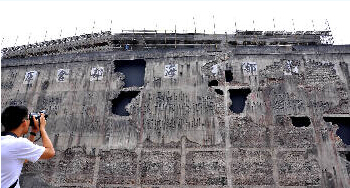United Chinese front against Japanese aggression
 0 Comment(s)
0 Comment(s) Print
Print E-mail China Today, September 2, 2015
E-mail China Today, September 2, 2015
| A Shanghai citizen takes a picture on July 8, 2015 of the bullet-riddled, bloodstained west wall of the Sihang Warehouse. |
Following the Lugou Bridge Incident of July 7, 1937, the Japanese army accelerated its invasion of China. China’s two political powers at that time, the Kuomintang (KMT) and Communist Party of China (CPC), jointly formed the Chinese united front against Japanese aggression in efforts to save the nation. The Chinese army fought against the Imperial Japanese Army in the eastern coastal city of Shanghai and put paid to their avowed ambition to “subjugate China in three months.” In central Shanxi Province, meanwhile, the Communist-led Eighth Route Army won a great morale-boosting victory at Pingxingguan, so dispelling the myth of the “invincible” Japanese army. China eventually emerged victorious after years of dogged resistance. Seventy years later, we revisited the battlefields of the onset of this long, bloody conflict.
Songhu Battle
The Shanghai Songhu Campaign Memorial Hall is in Linjiang Park in Baoshan District, the water portal in north Shanghai at the confluence of the Huangpu and Yangtze rivers. Deputy Party Secretary of the Memorial Hall Xu Rong told the reporters that the hall is site of the original seat of Baoshan County, and main battlefield of the two Battles of Songhu.
Exhibits in the memorial hall include scripts, old photos, relics, and duplicated scenes of the two Battles of Songhu.
Late on the night of January 28, 1932, the Japanese Marine Corps quartered in Shanghai were deployed in five divisions that attacked the Chinese troops guarding the Zhabei Defense District. The Japanese commander had earlier declared that his armies would capture Shanghai in just four hours. The defending 19th Route Army gave ferocious battle, killing and wounding 10,000 Japanese soldiers in 36 days. The Japanese were forced during this period to change their commander-in-chief three times.
The 1937 Lugou Bridge Incident marked Japan’s launch of its full-scale invasion of China. On August 13, Japanese troops attacked Shanghai, decimating Zhaibei and Nanshi districts. Chinese defenders then embarked on a three-month battle against the Japanese invaders. After six days and nights of deadlock, the Japanese finally used sulfur bombs and frangible grenades that razed Baoshan County to the ground. The defending troop, the Third Battalion under the 583rd Regiment of the 98th Division, fought to the last man. Commander Yao Ziqing and all 600 soldiers sacrificed their lives after running out of ammunition and supplies. There is a stele in the southwest corner of the park that bears the carved legend “Yao Ziqing Battalion Sacrifice Site.”
The Shanghai Songhu Campaign Memorial Hall exhibits include soldiers’ manuscripts and letters and such documents as the Memoirs of the Songhu Battle, the Military Record of the Song-hu Battle Against Japanese Aggression, and also a painting by a Japanese war correspondent. All document the Japanese invasion of Shanghai. Among them is one picture called Breaking into Zhaibei House K of Japanese soldiers wielding guns charging into ruined homes.
One memorial hall souvenir display cabinet contains commemorative “Sihang Isolated Troops Comrade Committee” medals. Sihang Warehouse, repository for Shanghai’s four big banks, is a six-storied reinforced concrete mansion on No.1 Guangfu Road on the north bank of the Suzhou River, opposite Shanghai’s foreign concessions. In late October 1937, Commander Xie Jinyuan and his 524th Regiment withstood a dozen onslaughts during a battle that lasted four days and nights, so giving cover to Chinese forces retreating west. The successful defense of the warehouse was a sorely needed shot in the arm for the Chinese army and civilians in the demoralizing aftermath of the Japanese invasion of Shanghai.
The bullet-riddled, bloodstained west wall of the Sihang Warehouse is still standing, and is now a memorial anti-aggression wall. This edifice is under restoration to commemorate the battle and the heroes who fought in it and sacrificed their lives.






